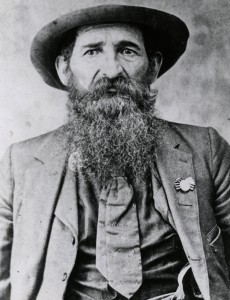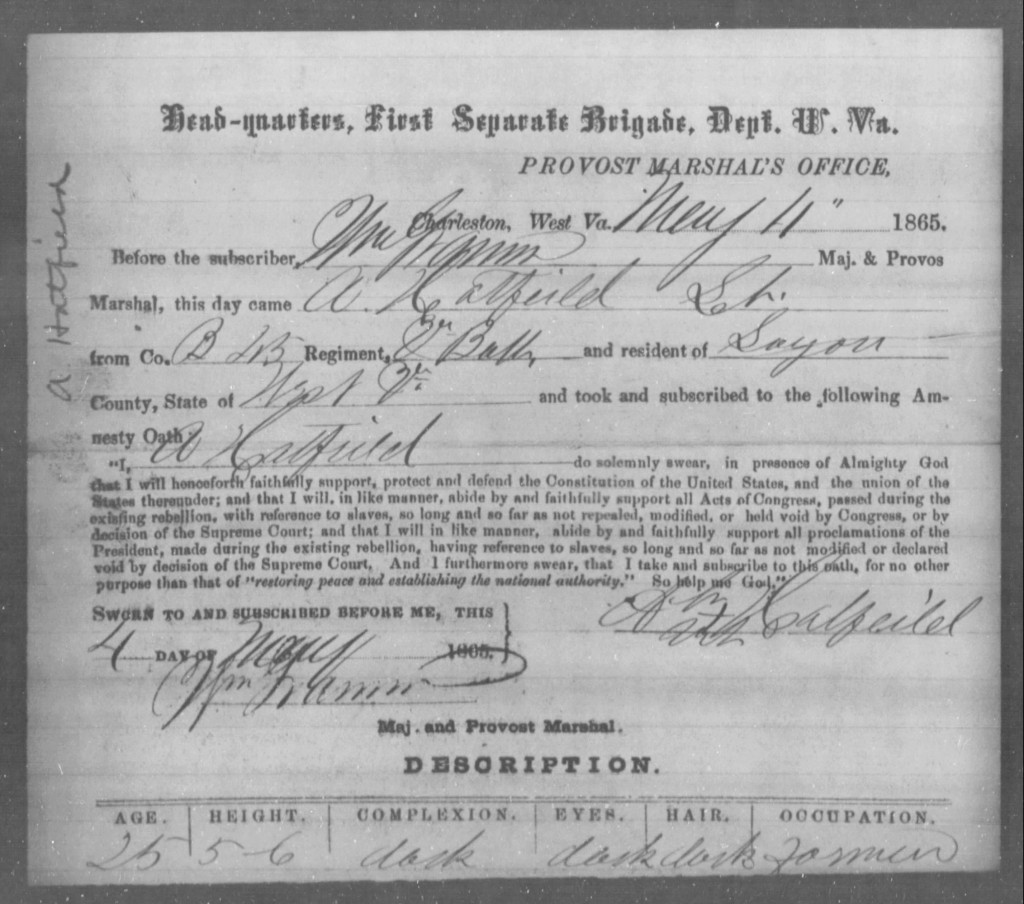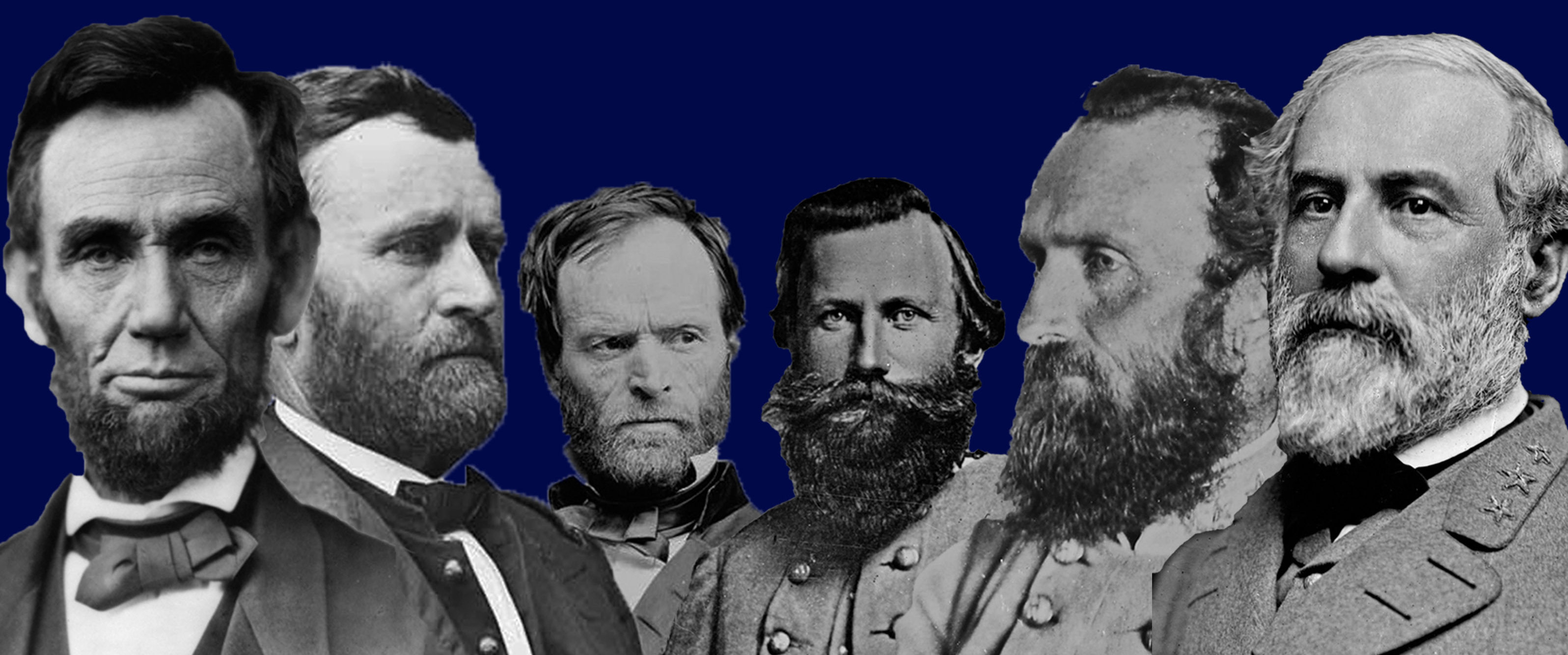
West Virginia and Regional History Collection
WVU Libraries
William Anderson “Devil Anse” Hatfield is best known for being the patriarch of the family involved in the famous Hatfield and McCoy Feud. Nearly twenty years prior to the start of hostilities with the McCoy family, however, Hatfield served in various units associated with the Confederate army.
At the start of the Civil War in 1861, Hatfield was a 21-year-old farmer from Logan County, Virginia (now West Virginia). Although he undoubtedly enlisted in a Confederate unit in the first year of the war, his service record during the time is ambiguous. No documentation exists connecting Hatfield to a particular unit in 1861; in fact, anecdotal evidence and family tradition link him to three different regiments during the first year of the war.
Hatfield’s documented Confederate service begins in 1862 when he was commissioned a First Lieutenant of Cavalry in the Virginia State Line. This regional unit was formed in May 1862 in order to protect the territory along the Kentucky-Virginia border where resident loyalties to the North and South were mixed. Those who agreed to enlist in the unit were promised they would serve their time in the rural regions near their home.
The Virginia State Line eventually disbanded in 1863 and Hatfield enlisted as a private in the newly formed 45th Battalion, Virginia Infantry. He was quickly appointed to the position of first lieutenant of Company B, and it appears that he was later made captain. The unit spent most of its time patrolling the border area against bushwhackers sympathetic to the Union; and with guerrilla warfare being so prevalent in the area, it is not surprising the Hatfield family found themselves the target of a raid. In an article about Devil Anse published in the October 1900 issue of Confederate Veteran magazine, the story is told of an attack on the Hatfield home:
The first who fell before his unerring rifle, except in war, was in the sixties. Living in the border land where sentiment was divided, he espoused the cause of the South, made up a company, was elected its captain, and marched forth to honorable warfare, leaving a wife and family at home. Some time, I think about 1863, a party of men such as always infest border territory went to his house and in a most brutal manner turned his family out. Nor was this near all the indignities to which they were subjected. On hearing of it, Capt. Hatfield secured leave of absence from the army, and promptly settled with the villains.
Early in 1864, dozens of soldiers, including Hatfield, deserted the Confederate unit for unknown reasons. Some sources maintain the desertions occurred because the 45th Battalion had been ordered to move out of the area and the men were not willing to leave their homes unprotected from bushwhackers. Hatfield family tradition, however, holds that Devil Anse left after refusing an order to execute one of his uncles for being absent without leave.
Although he left the regular Confederate army, Hatfield did not stop fighting for the South. He and several members of his former unit joined a partisan unit that continued to operate in the Tug River Valley region of the West Virginia-Kentucky border. Oral tradition holds that Hatfield fought alongside “Rebel” Bill Smith, the leader of a guerrilla band in the Logan County area of West Virginia. Many historians consider an incident that occurred during these partisan days as a seminal event for the future Hatfield-McCoy Feud.
Asa Harmon McCoy was a member of a Federal infantry unit in neighboring Kentucky. He also happened to be the younger brother of Randall McCoy – family patriarch in the later feud. In the latter months of 1864, Harmon McCoy was a participant in a border raid on the home of Mose Christian, a close friend of Devil Anse Hatfield. Although it is not clear who pulled the trigger, Christian was shot and killed during the incident. Hatfield vowed revenge on those responsible, and in January 1865, Harmon McCoy was found murdered. Not surprisingly, Devil Anse was the prime suspect, but he produced an alibi sufficient to avoid arrest. Many believe the perpetrator was actually Jim Vance, Hatfield’s uncle. While the murder would appear to be a likely source of tension between the two families, the McCoy’s did nothing to avenge the death at the time. In fact, the Hatfield-McCoy Feud would not start for another 13 years.
As the Civil War ended, so too did the border tensions in the region; and Devil Anse, along with other former Confederates, took his Amnesty Oath on May 4, 1865. His remaining years, however, would be forever haunted by the events of the subsequent Hatfield-McCoy Feud, as best described in Confederate Veteran:
Devil Anse goes always with a Winchester, a sack around his neck full of cartridges, a pair of good Smith and Wessons, and, I am told, that a pair of good Damascus blades luxuriate constantly from his boot legs.…He virtually sleeps with one eye open, or, as someone said, “sleeps on one side at a time.” He has been hounded by officers and enemies so long that he is ever alert and watchful, so much so that, in addition to the five senses being all perfect, the boys say that he has also an eye in the back of his head…. He was a good Confederate soldier, and is far more to be pitied now in his near three score and ten than condemned.

National Archives
His enemies never did catch up to him, and William Anderson Hatfield died of natural causes at the age of 81 on January 6, 1921.

The Mose Christian named in this article was actually Mose Christian Cline and he did not die of the gunshot wound. This has been passed down through our family history. Mose Christian Cline is listed in the 1880 census as disabled due to the gun shot wound to the chest. This would be the wound he received from ASA Harmon McCoy.
At the time of his death, Harmon McCoy’s oldest son was 12 yrs old. His 2nd oldest, my gr gr grandfather, Lark McCoy, was 9 yrs old. The murder was, indeed, a source of tension between the two families and Lark swore he would someday kill the man who murdered his father. In the 1880s he rode in the posse that tracked Vance down in WV, and killed him. What’s obvious to anyone who has researched the feud, is that there was not ONE single cause, but many over a long period of time. Patience is a characteristic that has been used to describe many of my ancestors.
I find it very hard to believe that the above amnesty oath belonged to Devil Anse Hatfield. The signer of the above oath is listed as being 5′ 6″. It is my understanding that Devil Anse Hatfield was over 6′ tall.
Whether accurate or not, the surviving Civil War service records for Anderson Hatfield of the 45th Virginia Battalion all list his height at 5 feet 6 inches.
In the archive picture I saw of Mr. Hatfield (devil anse) looks as though he is only 5’6 or so while sitting on that horse. I don’t think he was 6 ft or more but I wasn’t lucky enough to meet him.
Photos also suggest that Anse was not six feet tall. His height was inflated by later writers. Anderson Hatfield was not a common name in that area at that time. It is almost a certainty that any Anderson Hatfield mentioned in those Civil War records is the man referred to later as Devil Anse.
Firstly, Jim Vance cannot be proven to have ever fought with Hatfield in any regiment. Jim Vance lived in McDowell, was then Logan. Anse lived in Logan, now Mingo. Secondly, Asa McCoy died of frost bite as his widow said. As his military unit said of the troops. Adjunct General of the 45th, said “more men died of frost bite than of gun shot”. Thirdly, most families of the feud don’t exactly have anyone’s best interest except their own ancestor. Do the research. My opinion after researching the feud.
But the actual history if the Hatfield-McCoy Feud was changed and rewritten by the coal companies. Any crime going on in the area was a threat to their business. So what records that do or do not exist today are probably questionable, except for oral traditions handed down from the families who participated. Coal companies could and did forge documents, signatures, rip pages out of deed books, and make records disappear. Census records were also changed. Both Logan and Boone County Courthouses were burned during the Civil War. I have researched for 30+ years in that area-it pays to take Logan County written history, even courthouse records, with a grain of salt, until you find at least three corroborating sources, including oral history, before its reliable.
As for James Vance being in McDowell County, James and Vance are common names in that area. How did you determine that it was the same person?
Census records cannot be changed. There are not forged documents. Coal companies had no interest in any of this. The events of the feud ended by 1891. The coal companies didn’t even come into the area until the early years of the 1900s.
Jim Vance didn’t fight in a regular unit. He was the leader of the Logan Wildcats. A militia out of Logan County, WV.
Anse is my Gr Gr Gr Grandfather. He was indeed well over 6 feet tall. I have old pictures of him with my grandfather as a very small child. He was a lanky man, but not short by any means.
Although, he was reported to have an incredibly low BS tolerance. 🙂
Really? I am totally fascinated by the hatfield/McCoy history. I would like to hear, see and learn it. I love southern history. always have.
Just find different history websites and read them. You got the internet at the tip of your fingers so it can be a big power.
This is remarkable. I never knew this. There’s so much of my family history that i don’t know.
I think both families have been thru huge tragedies and plenty of sacrifice. I enjoy both side of the family history as i have a huge family as well. Not as large as H&M, but close. Our huge problems revolve around murder, incest, betrayal, and huge non-trust. I rely on pure facts not opinions. I have watched the H&M movie around 30 times. I can tell the movie does not tell the whole story. Im the only person in my large family to become a published Author, earned my MBA with Economics, double Bachelors in law, physics and quantum physics. The statue on Devil Anse grave which i have been to personally shows he may not have been over 6ft in height. Whether or not he was changes nothing. Reflecting upon how both sides of these families suffered beyond imaginable.
I suspect I am from Ellison Hatfield’s line. His murder was the event that triggered the violence.